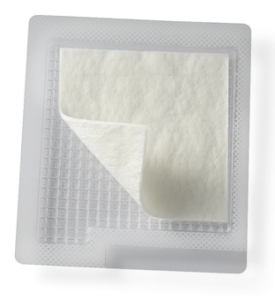Biologically derived reconstructive matrix
Hyalomatrix is a sterile, flexible wound device consisting of two layers: a non-woven pad of HYAFF, esterified hyaluronic acid (HA), and a semi-permeable silicone membrane.
A unique hyaluronic acid-based wound care technology, Hyalomatrix’s HYAFF fibers help facilitate the healing process in slow-healing and chronic wounds, including venous ulcers, diabetic foot ulcers, pressure ulcers, as well as second degree burns and surgical sites (1,2,3,4,5). The thin, semi-permeable silicone layer protects the wound from external contamination, controls moisture loss, and increases tear strength.

Available in Four Sizes.
- 1″ x 1″ (2.5 cm x 2.5 cm)
- 2″ x 2″ in (5×5 cm)
- 3.9″ x 3.9″ in (10 x 10cm)
- 3.9″ x 7.9″ in (10 x 20cm)

References:
1. Caravaggi C, Grigoletto F, Scuderi N. Wound Bed Preparation With a Dermal Substitute (Hyalomatrix® PA) Facilitates Re-epithelialization and Healing: Results of a Multicenter, Prospective, Observational Study on Complex Chronic Ulcers (The FAST Study). WOUNDS 2011;23(8):228–235. Available at: www.medscape.com/viewarticle/749515_1 Accessed on Oct 13, 2014.
2. Gravante G, Sorge R, Merone A, et al. Hyalomatrix PA in Burn Care Practice: Results From a National Retrospective Survey, 2005–2006. Ann Plast Surg. 2010;64(1):69–79.
3. Voigt J, Driver VR. Hyaluronic Acid Derivatives and Their Healing Effect on Burns, Epithelial Surgical Wounds, and Chronic Wounds: a Systematic Review and Meta-Analysis of Randomized Controlled Trials. Wound Repair Regen. 2012 May-Jun;20(3):317-31. Available at: www.ncbi.nlm.nih.gov/pubmed/22564227 Accessed Oct 14, 2014.
4. Longinotti C. The Use of Hyaluronic Acid-Based Dressings to Treat Burns: A Review. Burn Trauma [Epub ahead of print] [cited 2014 Oct 16]. Available from: www.burnstrauma.com/preprintarticle.asp?id=142398 Accessed Oct 16, 2014.
5. Moseley R, Walker M, Waddington RJ, Chen WYJ. Comparison of the Antioxidant Properties of Wound Dressing Materials–Carboxymethylcellulose, Hyaluronan Benzyl Ester and Hyaluronan, Towards Polymorphonuclear Leukocyte-Derived Reactive Oxygen Species. Biomaterials (Impact Factor: 8.31). 05/2003; 24(9):1549-57.